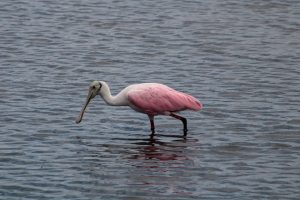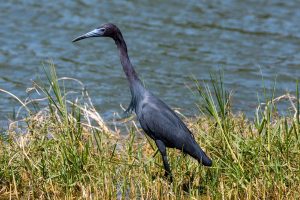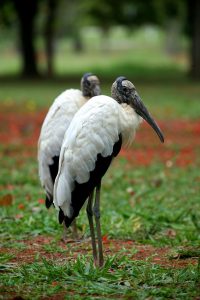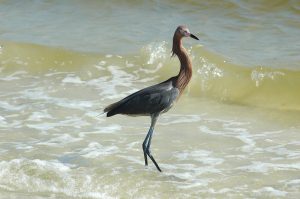Each year on December 4th, we celebrate World Wildlife Conservation Day. This day serves as a reminder of the urgent need to protect and conserve all of the unique and invaluable wildlife that live in our ecosystems.
In honor of World Wildlife Conservation Day, follow along with Extension as we highlight animals from Florida’s threatened and endangered species list, conservation efforts to protect them, success stories, and what you can do to support wildlife- before it is too late. If you missed the previous blogs in this series, you can find them here.
A Watery Wonderland

In many ways, Florida is a land of water. With the Atlantic Ocean, the Gulf of Mexico, and the Straits of Florida surrounding the peninsula, and more than 1,000 freshwater springs in the state, Florida is quite unique and spectacular. Additionally, “before Florida became a State in 1845, there were an estimated 20.3 million acres (8.2 million ha) of wetlands, which is the equivalent of a little less than 4 New Jersey-sized states” (Tyrna, 2018, par. 2). In this watery world, the low-lying landscapes and their plant, animal, and human inhabitants adapted to the ebb and flow of Florida’s flood cycles.
Our swamps, marshes, mangroves, and rivers all support a wide diversity of wildlife and plant species, but these critical, aquatic, sponge-like environments were not ideal for development, and as time went on, more and more wetland ecosystems were drained, diverted, altered, and filled. Today, this process continues, and is compounded by the introduction of nutrient-rich runoff and other pollutants that impact the health and quality of Florida’s waters and wetlands.
Where to Wade?

For the threatened and endangered species of graceful, long-legged wading birds that forage and hunt in Florida’s aquatic environments, the alteration and destruction of these environments puts their survival at risk. While populations of wading birds such as sandhill cranes may appear to be doing just fine, as we often see quite conspicuous pairs of the leggy birds as they ever-so-slowly cross roads, there is more to the story.
Threatened or Endangered?

According to the U.S. Fish and Wildlife Service, an endangered species is a plant or animal whose population is in danger of becoming extinct (dying-out) in all or most of the areas where that species lives (n.d.). A threatened species is a plant or animal whose population is “likely to become endangered within the foreseeable future throughout all or a significant portion of its range” (USFWS, n.d., par. 3).
Understanding these two definitions is critical when discussing Florida’s at-risk wading bird species. As the common saying goes, prevention is the best medicine, and recognizing that a species is threatened before it becomes endangered allows conservation scientists the time needed to better understand how to protect that specific species, and for multi-agency efforts to be employed to address the issue.
Florida’s At-risk Wading Birds

- Florida sandhill crane (Antigone canadensis pratensis): State-designated threatened
- Little blue heron: (Egretta caerulea): State-designated threatened
- Reddish egret: (Egretta rufescens): State-designated threatened
- Roseate spoonbill: (Platalea ajaja): State-designated threatened
- Tricolored heron: (Egretta tricolor): State-designated threatened
- Wood stork: (Mycteria americana): Federally-designated threatened

The charismatic nature and captivating appearances and feeding behaviors of these threatened species fascinate many bird enthusiasts. And while you may have had the opportunity to see some of these species, the decline of healthy wetland habitats, water pollution, alteration of natural, seasonal flood patterns, climate change, and the resulting decline of preferred prey items has resulted in decreases in population- threatening the ability of these species to persist in the future.

The plight of wood storks in particular has warranted the status of federally-designated threatened. This unique wading bird depends upon natural, seasonal flood cycles, which create an abundance of amphibians, crustaceans, and fish in a concentrated area, as water in South Florida wetlands such as the Everglades recedes in the dry season.
Memories and Moments of Magic

When elders and long-time locals share stories of the abundance that once was, and the frequency at which they saw species that today we would be lucky to catch a glimpse of, there is a sense of loss and of just missing out on something. The youth that are growing up today may never see some of the species that their grandparents and great-grandparents grew up with, and that sense of loss is not only for the animals, but the memories and traditions that they have been a part of.
Whether through family fishing, camping, canoeing, or hiking trips, the wildlife that share this world with us have always been alongside us. I will never forget the wide eyes and giggles of the students in our LIFE program, as they catch a glimpse of a roseate spoonbill flying by or hear the cacophonous squawks of herons as they learn about Myakka River State Park’s biodiverse freshwater ecosystems. We need these moments of wonder and inspiration, and wildlife are a critical part of them.
What Can You Do to Help Our Watery World?
It is much better to conserve a species before it is endangered, than to watch as animals that we know and love disappear. Here are a few suggestions and things to remember when it comes to the conservation of Florida’s wading bird species.
- While they do offer benefits, stormwater or retention ponds do not have the same ecosystem value as natural wetlands. It is important to support smart, sustainable, well-planned development that protects existing natural wetland environments.
- If you have a retention pond in your neighborhood, learn how your community can improve the health and quality of the water, and help provide habitat for wading birds by participating in the Healthy Ponds Program.
- Support land acquisition and conservation easement programs that conserve wetland ecosystems.
- Reduce pollution by practicing sustainable agriculture and responsible management of pesticide and fertilizer use and runoff.
- Landscape with Florida Friendly native plants in place of water intensive nonnative plants and grass lawns that require unsustainable amounts of water to maintain.
- Volunteer with conservation organizations to monitor wildlife species, restore natural areas, plant native plants, clean up ecosystems, and more!
Learn More
There is so much exciting work being done in the field of wildlife conservation, and Florida offers us the opportunity to learn from many unique case studies of both cautionary tales and success stories. With greater education, advocacy, and collaborative efforts, we can protect wildlife and the habitats that they depend on- for their sake and ours!
Follow along with this blog series to learn more about Florida’s threatened and endangered wildlife species, conservation efforts to protect them, success stories, and what you can do to support wildlife.
- For free webinars and resources about Florida’s wading bird species, visit UF/IFAS Extension Sarasota County’s Wildlife webpage
- Learn what the county is doing to improve and protect water quality with Sarasota County’s Water Quality Story Map
- To view FWC’s Endangered and Threatened Species List for 2022, visit this site.
Find Other Blogs In This Series
Under Threat: Conservation of Florida’s Threatened and Endangered Species
Under Threat: The Florida Panther
Resources
Tyrna, A. (2018, May 17). The importance of Florida wetlands. UF IFAS Blogs. https://blogs.ifas.ufl.edu/sarasotaco/2018/05/17/the-importance-of-florida-wetlands/#:~:text=Before%20Florida%20became%20a%20State,4%20New%20Jersey%2Dsized%20states.
U.S. Fish and Wildlife Service. (n.d.). Listing Status. IPaC. https://ipac.ecosphere.fws.gov/status/list#:~:text=Threatened%20(T),(d)%20of%20the%20ESA.
Source: UF/IFAS Pest Alert
Note: All images and contents are the property of UF/IFAS.



